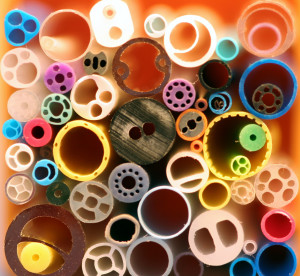This is a brief blog post to get an idea into the public domain to prevent its being patented. I’ll probably work up more detail later.
Plastic extrusions are widespread: guttering, pipes, curtain rails and so on are all examples. A conventional 3D printer can make a short length of such shapes of course. But it should also be possible to remove the bed of a 3D printer and to run the printed shape out of the bottom between sets of rollers and print an arbitrarily long length of any shape. The rollers effectively become the machine’s Z axis.
The process would be slow, of course. But for the cost of one conventional extrusion machine you could buy a few hundred 3D printers, which collectively would be quite fast.
Unlike ordinary extrusion machines, the printers would be able to incorporate periodic features as well, such as, say, screw holes or projecting lugs every 100 millimetres.
To initiate a printed extrusion the machines might have a flat-ended square-section blank half a metre long. This would form the ‘bed’ on which the print started and would run through one set of rollers. Once the print was long enough other rollers above them would be deployed, positioned in a custom fashion to accommodate the particular profile being printed.
Best wishes
Adrian
Connect with us
Keep up to date on the latest RepRap Ltd news:




Sounds a bit like the Black Belt 3D printer.
Yes, though the mechanism is different.
Black Belt are patenting ““the belt material, an adjustable angle for the extrusion plane, and G-Code manipulation.”
This uses none of those, and so is free for open-source, and none of its ideas can now be patented.
This is a great idea! The only problem that I can think is the strength of the 3D printed parts will be lower in the Z-axis because of the interstitial layer weakness. But of course, the flexibility offered and the periodic features that could be offered would make up for it.
Thanks for ensuring this idea cannot be patented and is now in the open source.
I was planning to upgrade / rebuild my fisher with longer slideways to enable printing long sections such as turbine blade moulds/ formers. However if you add a drive to make the bed lowering ( gravity assist ), then you have a super tall variant capable of making extrusion.
You then need to either print the mould & cast into it ( best material properties ) or print the profile & anneal it .